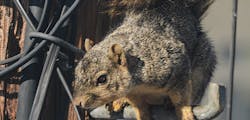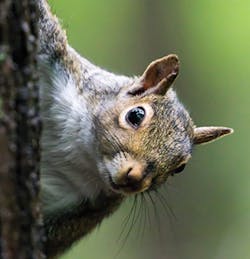Every day in every part of the world, squirrels and other furry rodents have been playfully frolicking in our trees and on telephone poles, providing us with an amusing show of their acrobatic skills. But from the very beginning of telecommunication’s existence, these frustrating furballs have been the bane of most lineman’s lives, wreaking havoc on the infrastructure in place to deliver lightning-fast services. Almost 40 years ago, a short article in the February 1979 issue of Popular Science discusses ongoing work at Bell Labs at that time seeking to understand the biting behavior of rodents and its effect on cable.
Each year, operators and customers alike face the same problems of intermittent services due to cable being chewed and destroyed by these furry little acrobats. Their chewing can result in the outright destruction of the information-carrying wires or fibers within a cable. Of course, if the chewing does not disturb the integrity of the traffic-carrying parts of a cable, damage to the cable’s outer jacket may create an ingress path for water, resulting in corrosion and other cable damage.
Squirrels are among the species known as synanthropes, those that share the same environment as humans. Their populations are strong in urban and suburban areas where they thrive on the nuts and seeds of various oak, maple, elm, and other trees. It is estimated that many large urban areas are now at least 1/3 covered in such trees, forming an environment suitable to allow people and squirrels to co-exist.
To fully understand why squirrels seemingly love chewing cable, you need to get inside of a squirrel’s head — literally! Imagine if your teeth grew endlessly, forcing you to find creative ways to control that growth or they would eventually ruin your face and cause excruciating pain. In fact, an adult squirrel’s 4 incisors can grow as much as 8 inches per year. This growth, if not kept in check through gnawing, could rapidly lead to the animal not being able to open its mouth to eat — causing certain death.
In the wild, incisor growth is largely kept in check through activities such as the natural gnawing action that a squirrel undertakes to open a nut with a hard shell. In an urban environment, these animals may have at least part of their diet come from human sources: food grown in urban gardens or discarded in the trash, for example. Such "soft" foods contribute nothing to curbing incisor growth, making secondary gnawing an absolute necessity for the squirrel.
Solutions to the problems created by squirrels in cable plant have generally taken one of three general approaches. These can be broadly categorized as lethal toxins, physical barriers, or repellents. (See Figure 1.)
Lethal Toxins
Lethal toxins eliminate the problem by exterminating the rodent. Clearly, such a lethal approach ensures that the offending animal cannot repeat the behavior.
The downsides of introducing poisons into the environment are profound, however. Toxins may be inadvertently directly ingested by non-target species, including pets and even children. Also, by consuming the carcass of a poisoned rodent, secondary species may also be killed. For these reasons, network operators, particularly those in urban areas, should avoid such risks.
Physical Barriers
The physical characteristics of network cables play an important role in determining the need for additional protection against squirrel damage. Cables with an outside diameter of 1.9 cm (0.75") or more are less likely to suffer squirrel damage for the simple reason that rodents cannot open their mouths wide enough to gnaw on them. Unfortunately, the fiber cables being pushed ever deeper into neighborhoods are being placed specifically because they carry a great amount of traffic while having a small diameter. For these then, a physical barrier, repellent or combination of the two, is required.
InvisiLight® Solution for Deploying Fiber
April 2, 2022Go to Market Faster. Speed up Network Deployment
April 2, 2022Episode 10: Fiber Optic Closure Specs Explained…
April 1, 2022Food for Thought from Our 2022 ICT Visionaries
April 1, 2022Physical barriers might include armor, conduit, and deterrents, to prevent rodent access to the sensitive parts of a cable.
Armoring: A common method of armoring is the use of corrugated carbon steel tape wrapper longitudinally around the cable’s core. Because the tape is hard, it can be fairly effective at limiting rodent access to a cable’s core. Of course, if a cable’s outer jacket is breached before the rodent is stopped by the steel, corrosion from water may be a problem.
Conduit: Extruded plastic ducts typically have an outside diameter that is large enough to make gnawing extremely difficult, if not impossible. Likewise, triangular structures that exceed squirrel bite dimensions may be tented over the entire length of a cable, discouraging the rodent’s mastication attempts. Conduit solutions such as these can be effective but add cost and can be unsightly. Further, the added surface area of these solutions increase the wind and ice load of the cable, presenting a more challenging OSP engineering challenge.
Deterrents: Another method used to lessen squirrel access to cable is simply to deter their ability to get to it. Used more by power utilities than network service providers, devices such as barrier disks at the end of a cable are used to discourage rodent encroachment. Mounted at each end of a cable, these disks serve as a "fence" which spin freely, making it impossible for the squirrel to climb over and gain access to a cable. Of course, given these acrobatic animals do have the ability to leap over large objects, the cable on the other side of the disk often has the secondary protection of large "beads," which also spin freely around the cable. When the weight of the squirrel comes upon them, they spin freely to send the rodent to the ground.
Repellents
Studies suggest that behavioral barriers, such as those created by repellents, can be very effective at minimizing cable damage caused by squirrels. The key behind this methodology is to choose solutions that will alter the behavior of the animal, ideally permanently.
Perhaps the most common solution in this category is the incorporation of chemicals in the outer jacketing of cables that prove to be unpleasant for the rodent. These products work by offending the squirrel’s senses:
Taste: by adding a bitterant or extremely foul-tasting component to the cable sheath.
Discomfort: by adding a component that causes severe distress to the extremely sensitive mucosa of rodents.
Fear: by exploiting the olfactory response of animals to compounds that mimic the behavior of predators.
It is important to note, while squirrels gnaw on cable out of necessity, they do not necessarily ingest what they chew. This may make a solution that solely relies on "bad taste" less effective than expected.
It is also important to remember that any solutions used in cable jacketing should be environmentally safe and animal friendly.
Further, given both humans and rodents are mammals, it is critical that any chemicals used do not create a need for special handling of the cable, if at all possible. For example, using natural ingredients such as those found in hot peppers may prove a deterrent to rodents, but may also cause skin irritation to handlers with sensitive skin.
Ideally, repellents embedded in cable jackets will offend squirrels in several ways, such as Taste, Discomfort, and Fear. RodentRepel®, a product of Amphenol Broadband Solutions, takes such an approach. It utilizes special plant extracts, and other proprietary components in the outer sheath of the cable products, which affect the senses of the animals, while not requiring special handling.
Over time, the best repellents train the animal, similar to when a child who touches something hot for the first time. The rodent begins to associate its cable gnawing with an unpleasant experience. This learning provides a permanent detterent to the cable gnawing behavior of each squirrel. Studies conducted by various cable vendors consistently report rodent gnawing damage reduction of 95% or more when cable jacket repellents are used.
As long as service providers deploy aerial cable, the problem of gnawing by squirrels will not go away. By utilizing one or more of the techniques described in this article, damage to critical infrastructure can be minimized. Coupling any of these, along with a strict maintenance program that keeps trees and vegetation clear of cables, will pay dividends in maintenance costs, and customer satisfaction, over the long haul.
Additional Author: Bill O’Donnell is the Director of Product Management for Amphenol Broadband Solutions, He has been working in the telecommunications industry for over 20 years. Bill works with network providers to help define their challenges for which he draws on the corporation’s global resources to develop innovative solutions. He may be reached at [email protected].
About the Author







